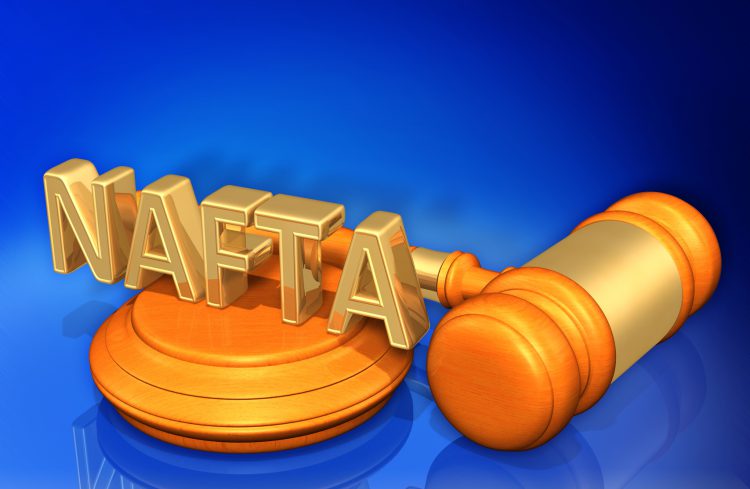Trump and Trade

On June 6, Chrystia Freeland, Canada’s Minister of Foreign Affairs, delivered an interesting speech to the House of Commons. It is being viewed as a manifesto outlining the response of our federal government to recent international events. It was followed closely by a speech by Harjit Sajjan, which referred to Ms. Freeland’s speech and proceeded to outline Canada’s revised defense policy. The Prime Minister has spoken of both speeches in supportive terms and there has been much comment on them in the media.
Ms. Freeland’s speech has been reported as a strong response to Mr. Trump’s adventures in foreign policy and trade with echoes of Angela Merkel’s speech the previous Sunday in which she stated that “recent events,” likely meaning the recent G7 Conference, have shown that Europeans in general and Germany in particular can no longer rely on others. If that is the case, all western nations must rethink their foreign policies.
Ms. Freeland’s speech touched on many big themes, including the post-war global international order. This is the web of supra-national organizations established after the Second World War to promote international reconciliation of disputes (the United Nations), international financial stability (the World Bank) and the free movement of goods and services (the GATT, which has now become the World Trade Organization). Many credit these institutions and the broad policies they promote as being the cornerstone of the relative peace and prosperity that have been the happy lot of the western world since 1945. These institutions were largely developed and funded by the United States. Mr. Trump’s activities have been interpreted as a reconsideration of that role by the United States.
Ms. Freeland committed Canada to supporting those institutions and the multilateral agreements that support them. The North American Free Trade Agreement is part of that order and Canada is committed to making it work.
Mr. Trump has no time for any of this, nor do the people who voted for him. They want their jobs back and they do not care how that happens. Mr. Trump says the rest of the world stole those jobs in unfair trade deals that ivory tower liberals approved. He intends to use his considerable authority on the international stage to reverse those bad deals.
The negotiations will start in August, we expect, and will probably take a while. The chief negotiator for the United States is Robert Lighthizer, an experienced trade negotiator who has worked on NAFTA before. He has also acted for U.S. companies seeking access to other markets and for foreign companies seeking access to U.S. markets. He has now been appointed by the President to make NAFTA fair for America.
We can expect Mr. Lighthizer and his team to be capable and committed to the task they have been given. However, it is unlikely that they will be interested in presiding over the failure of NAFTA. There will be a formal list of American goals circulated in mid-July but we already have a good idea of the issues from a draft letter sent by the White House to Congress at the end of March, 2017. I will not address all of the issues raised, but you can find a copy here. The rest of this blog is about the draft letter.
Some points stand out for me. In the section of the draft letter labeled “Trade in Goods,” one of the headings is “Seek to level the playing field on tax treatment.” This is likely a reference to the “adjustable border tax” that Republican members of the House of Representatives have been working on.
Although this is a worrying notion, not many commentators are paying much attention to it now. The adjustable border tax was originally conceived as a revenue generator to support a plan to reduce U.S. corporate taxation a bit and personal taxation a lot. The origin of the disparity is that the United States has an unusual revenue model. It has taxed corporations at high levels while taxing individuals at relatively low levels and not taxing consumption at all at the federal level. Most other western countries tax corporations at relatively low rates, individuals at relatively high rates and place significant reliance on consumption taxes (the HST). This disparity in corporate taxation can lead to U.S. corporations seeking to shift their income to relatively low tax jurisdictions, such as Canada.
Under the new Trump plan, U.S. taxes would be reduced significantly for corporations and individuals. If U.S. corporate taxes are lower than those in Canada, leveling of the tax playing field would permit Canada to place a border tax on U.S. goods and services coming into Canada. It is unlikely that this is the result U.S. negotiators will seek. Also, Mr. Trump has disparaged the adjustable border tax as “too complex.” That is a fair comment even if it does come from an unusual source.
However, Mr. Trump’s tax plan has an obvious flaw in that it will create a significant revenue shortfall. Until now, the supporters of Mr. Trump’s tax plan have argued that lower taxes will produce “terrific” economic growth and higher incomes so more revenue will be generated at the new lower rates of taxation. This could be hard to sell to small “c” conservatives and we may see the border tax or other revenue generating ideas surface as Mr. Trump’s tax plan is debated in Congress.
Changing topic, the draft letter includes many statements which target the free movement of agricultural goods. Mr. Trump has made a number of comments on how unfair Canadian-managed markets in dairy products, poultry and eggs are to American farmers. Many Canadian consumers would applaud cheaper cheese, but I have not seen many federal politicians on this bandwagon. As Mr. Trump knows, rural voters punch well above their numbers when it comes to federal elections and agricultural subsidies and supports are a beloved tool on both sides of the border. It would surprise me if there is much movement on these particular issues.
The draft letter also raises issues regarding the rules of origin. These are the rules that limit the amount of an article assembled in Canada that can be sourced from somewhere else. So, if an auto maker merely assembles parts made somewhere else, can it expect the assembled article to be treated as “Canadian” for the purposes of NAFTA? The draft letter is quite circumspect on this point, speaking of the need to recognize “global value chains” while also emphasizing the overriding goal of creating jobs in the United States “without creating unnecessary obstacles to trade.” On this point, Canadian interests probably align with those of the United States. It is reasonable to assume that any reduction in the amount of goods produced elsewhere that qualify for the NAFTA tariff reductions will result in the creation of opportunities to make those goods in Canada, the United States or Mexico. That could benefit all member countries. However, too much of that would disrupt the global value chains that result in cheaper cars for consumers. I expect this to be a very hot topic and, perhaps, an area where significant change may occur.
The draft letter has a large section on the protection of intellectual property rights. This could be troublesome for Canada as we have a pharmaceuticals industry largely based on the production of off-patent generic drugs. The United States has argued that Canada’s approach to patent law does not do enough to protect the intellectual property of Americans. Canadian generic pharmaceutical companies have been active in seeking to undermine patents filed in Canada by U.S. companies, based upon the difference in approach that has emerged between the two countries. My partner, Dr. Kimberly McManus, is preparing a more detailed treatment of this issue that will be posted shortly. For the purposes of this blog, though, it is fair to say that, while the Canadian and U.S. patent regimes are very similar, U.S. enforcement provides more latitude to patent holders while Canada has been more restrictive. So, if a patent application states that a drug will do (“promises”) a specific thing, that patent can be rejected if the broad claim does not meet that promised utility. This is referred to as Canada’s “promise doctrine.” In the United States, this kind of language would not generally have the negative effects for patent holders that it appears to have in Canada. The United States would like Canada to adopt, perhaps through NAFTA, enforcement processes similar to the approach they use. Canada has resisted this in the past. However, Canada is taking steps to better harmonize its patent system with those of other countries, including the United States, under a number of multilateral agreements. It is likely that the United States will be looking to see Canada build on that movement in the NAFTA talks.
The final topic for this blog is the American dislike of the dispute settlement mechanism under Chapter 19 of NAFTA. This Chapter is large and was heavily negotiated. It establishes a complex set of rules for choosing panels of lawyers and others from the three parties to NAFTA to resolve disputes. Mr. Trump has complained that the system is unfair because the United States has never won a dispute. There might be a reason for that other than bias, of course. On the Canadian side, we could complain that the right of U.S. investors to claim compensation under Chapter 11, which provides a different but similarly complex regime for the resolution of investor claims, has been exercised far too often and successfully by American businesses. Again, this result may have nothing to do with the NAFTA process and everything to do with local perception.
It is hard to see the existing dispute resolution mechanisms surviving these negotiations. What will emerge is hard to say, but it is likely possible to examine the now substantial record of disputes and resolutions and see if a consensus can be reached on what, if anything, “went wrong” with these mechanisms. Resolution is possible if there is consensus. If no consensus exists, these discussions could be very difficult indeed. At the end of the day, free trade is an ideal and its implementation is political. Whether or not Mr. Trump would consider any resolution “fair” that does not support his political agenda in every way is open to question.
And that is the big problem with all of this. Mr. Trump is President of the United States and has much more power in international affairs than he does domestically. The people renegotiating NAFTA on behalf of the United States answer to him and, ultimately, he can fire them if he does not like the deals they are making. If he leaves his team to negotiate an updating of NAFTA, a lot of good things could emerge for all parties. If he insists on making this a political debate in which the United States must win at every turn, it could well result in serious disruption, if not failure. Hopefully even Mr. Trump would recognize that as being a bad thing.

